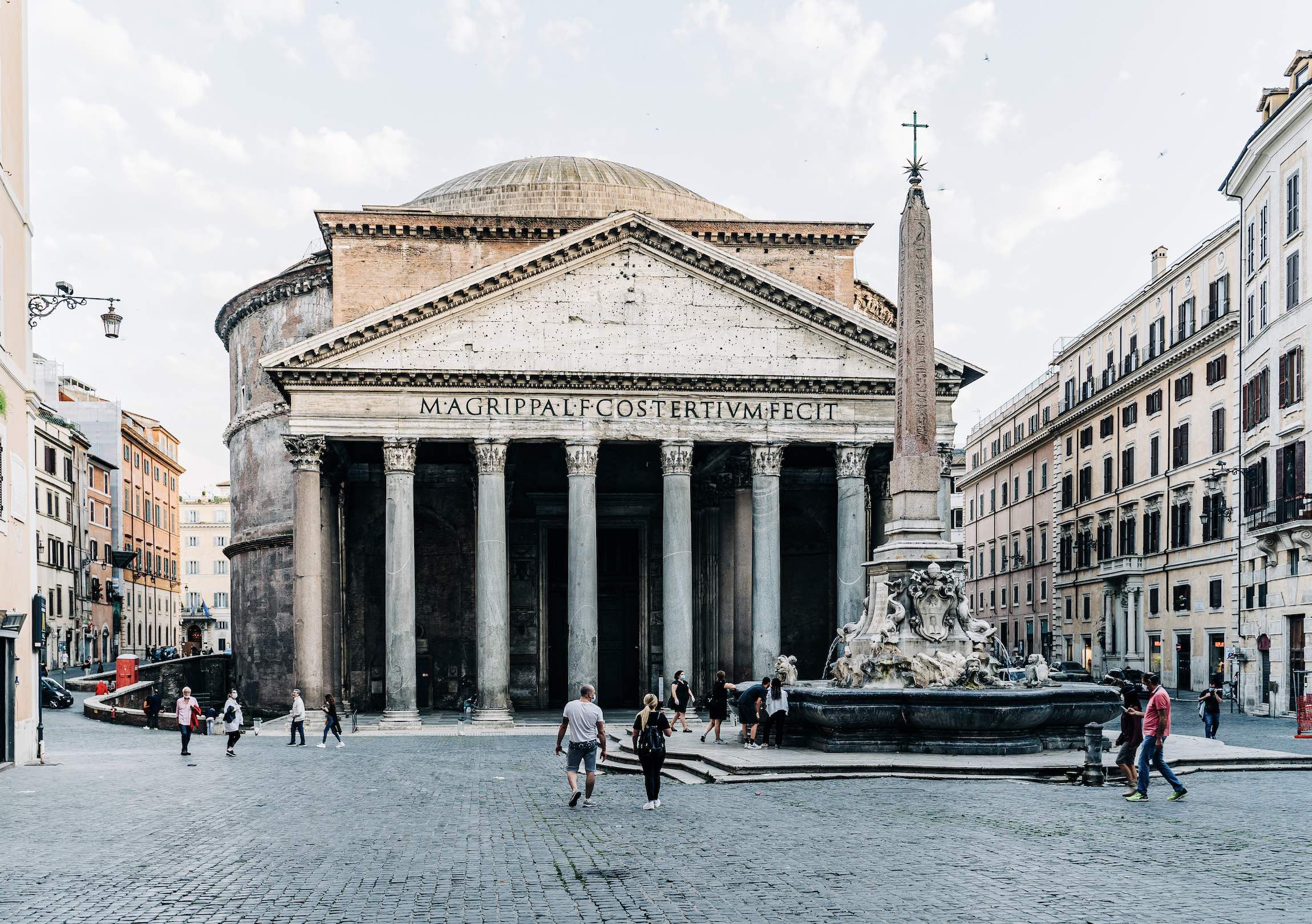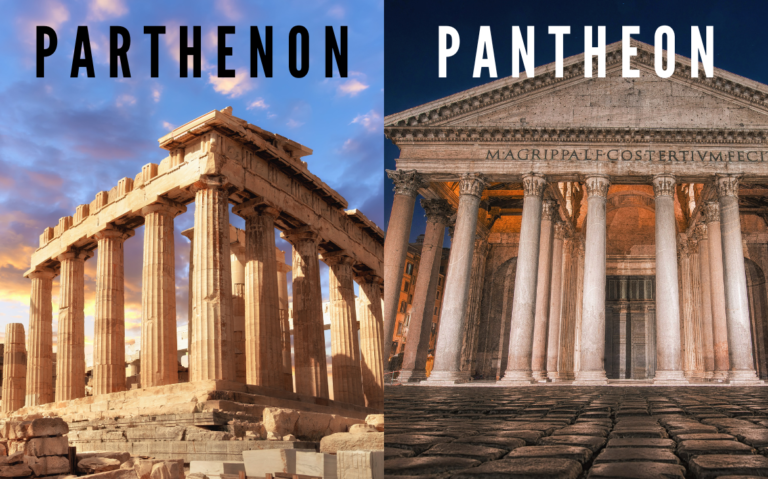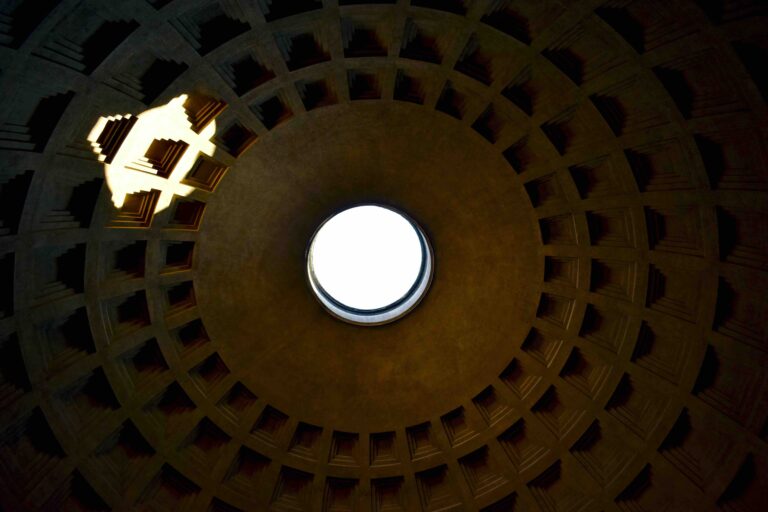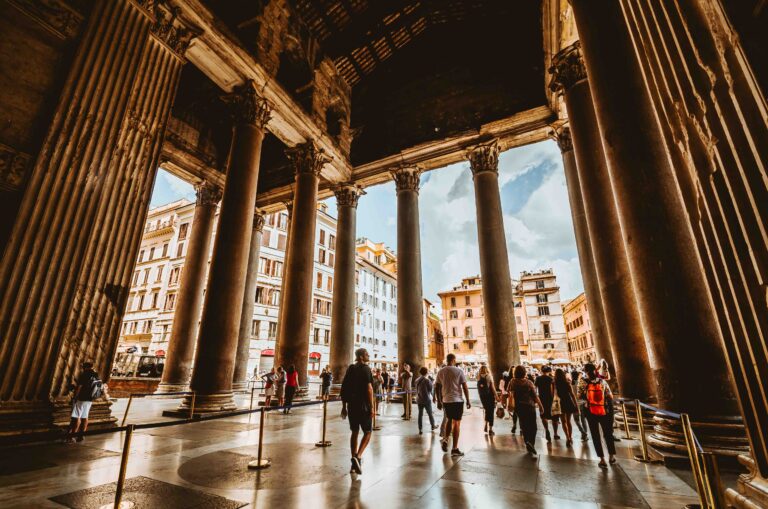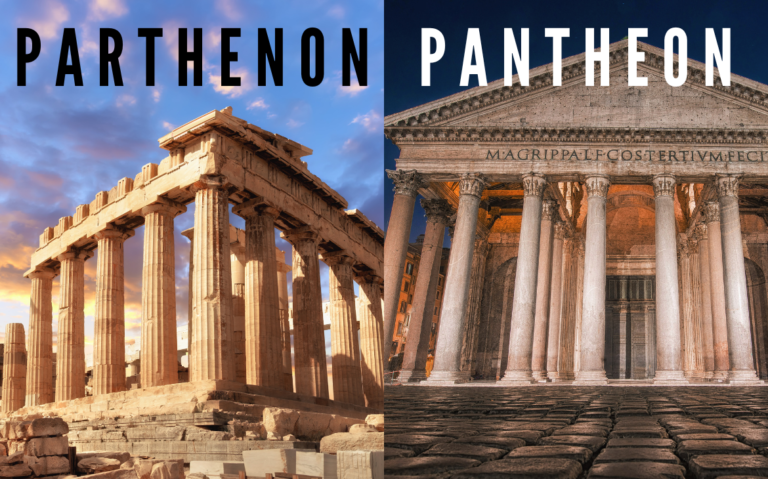You’re standing in the heart of Rome, gelato in hand, swept up in the lively chaos of the Piazza della Rotonda. Before you, rising with a quiet dignity that seems to silence the modern world, is the Pantheon. Your eyes travel up its massive, time-worn steps, past the crowds, and there they are: the sixteen majestic Pantheon Rome columns. They don’t just hold up the roof; they hold your gaze. They are the gateway to one of the world’s most perfect buildings, and they have a story to tell. It’s a tale of pharaohs, emperors, and engineering so bold it still takes our breath away 2,000 years later.
I’ve been guiding tours here for over a decade, and I never get tired of watching people encounter these stone giants for the first time. The questions are always the same: “What are they made of?” “How did they get here?” “Are they even real?” Today, we’re going to answer all of that. Consider this your personal, behind-the-ropes tour of the most impressive front porch in history.
The First Question Answered: What Are the Pantheon’s Columns Made Of?
Let’s start with the most obvious question. When you run your hand over the cool, speckled surface of a Pantheon column, you’re touching a piece of ancient Egypt. These are not just any stones; they are monolithic shafts of Egyptian granite.
What does “monolithic” mean? Simply put, each column was carved from a single, gigantic piece of stone. No stacking, no piecing together. Imagine finding a perfect, grayish-pink stone, taller than a three-story building, and carving it into a flawless cylinder. Then, imagine doing that fifteen more times.
Now, look closer. You’ll notice most of the columns are a distinctive gray, known as Granito del Foro. But shift your gaze to the very first column on the left and right. See that richer, almost rosy color? That’s Granito Rosso, or red granite, hauled all the way from the quarries of Egypt’s Eastern Desert.
The Romans didn’t use this stone because it was easy. They used it because it was the best. Egyptian granite was famed for its incredible strength and beautiful, speckled texture. By using it for their most important temple, they were making a powerful statement about their empire’s wealth, reach, and taste. It was the premium building material of the ancient world, and the Pantheon Rome was its ultimate showcase.
The final touches are just as deliberate. Look up at the tops of the columns. You’ll see intricate, leafy designs carved from a brilliant white marble. This is Pentelic marble from Greece, the same used for the Parthenon. The Romans, in their relentless pursuit of perfection, combined the best granite from Egypt with the best marble from Greece, right here on this portico. It’s a stunning display of the ancient world’s global economy.
A Journey of Imperial Power: Where Did the Columns Come From?
So, how did 60-ton pillars of Egyptian granite end up in the center of Rome? This is where the story gets truly epic. The journey of these columns is a saga in itself, a testament to Roman ambition and logistical genius.
It begins in the scorching deserts of Egypt. Teams of skilled workers, using little more than wooden wedges and bronze tools, would painstakingly quarry these massive blocks. They’d locate a flawless vein of granite, carve channels around it, and drive in wedges soaked in water. The wedges would expand, slowly, miraculously, cracking the stone from the earth. It was a process of immense patience and force.
Once free, the real challenge began. Each column had to be transported over 2,000 miles to Rome. Think about that for a moment. There were no diesel engines, no container ships.
The journey was a three-part marvel:
- The Nile: The columns were loaded onto barges and floated down the Nile River, a natural ancient highway.
- The Mediterranean: At the port of Alexandria, they were carefully transferred onto massive, sea-going cargo ships for a treacherous voyage across the Mediterranean Sea. Storms, pirates, and the sheer weight of the cargo made every trip a gamble.
- The Tiber: Finally, they arrived at the port of Ostia and were transferred once more onto smaller river barges to be pulled up the Tiber River, right to the heart of the city.
This entire, unbelievable process wasn’t for a new building. Historians believe these very columns were originally commissioned by Marcus Agrippa for the first Pantheon on this site. When that building burned down, Emperor Hadrian, in a brilliant act of recycling, reused Agrippa’s columns for the new Pantheon we see today. He was honoring the past while building for the future, a very Roman thing to do. So, when you look at these Pantheon Rome columns, you’re looking at artifacts that have witnessed two different magnificent temples, a true bridge across centuries.
By the Numbers: The Staggering Statistics of the Portico
Sometimes, to truly appreciate something, you need to look at the numbers. The statistics behind the Pantheon’s portico are so staggering they help put its scale into perspective. This is where the “wow” factor really kicks in.
Let’s break it down:
- The Number: There are 16 columns in total. They aren’t just lined up in a single row. They’re arranged in a deep, three-row formation. You see eight across the front, with four more behind them, and then another four behind those. This creates a grand, forest-like effect that you walk through before entering the main rotunda.
- The Dimensions: Prepare to be impressed.
- Height: Each column stands 39 feet (or 11.8 meters) tall. That’s about the height of a standard three-story apartment building.
- Diameter: At their base, they are 5 feet (1.5 meters) thick. You couldn’t wrap your arms around one even if you tried.
- Weight: This is the real showstopper. Each one of these monolithic giants weighs approximately 60 tons. That’s roughly the equivalent of a fully loaded semi-truck… hoisted vertically into the air.
- The Details: The white, lacy capitals at the top of each column are carved in the Corinthian style, the most ornate and decorative of the classical orders. The bases they stand on are also made of white marble, all resting on the original Roman travertine pavement, the very same stones you walk on today. You are quite literally following in the footsteps of Romans from 2,000 years ago.
This harmonious use of numbers and geometry is a hallmark of Roman architecture. The portico isn’t just big; it’s perfectly proportioned to create a sense of awe, preparing you for the immense space you are about to enter. It’s a deliberate, psychological prelude to the wonder of the dome.
Engineering the Impossible: How Did They Lift 60-Ton Columns?
Alright, so we’ve got these 60-ton Egyptian obelisks, I mean, columns, sitting on the banks of the Tiber River. Now for the million-dollar question: how on earth did the Romans lift them into place, perfectly vertical, without a single modern crane?
This is my favorite part of the story because it highlights the sheer genius of Roman engineering. They didn’t have steel or hydraulics, but what they did have was an profound understanding of physics and an army of determined workers.
The answer lies in an incredible machine: the Roman crane. Picture a massive wooden structure, like the skeleton of a tower, with a thick, horizontal arm. Now, here’s the brilliant part. Instead of a motor, the power came from a giant treadmill inside the crane, a wheel called a saccaria. Men would walk inside this wheel, like human hamsters, to generate the lifting force. This power was transferred through a complex system of ropes, pulleys, and winches.
The process was a delicate, dangerous ballet. First, the column would be levered onto a stable foundation. Ropes and lifting tongs were secured around it. Then, on the command of a chief engineer, the men in the treadmill would start to walk. Slowly, agonizingly slowly, the crane would creak and groan, and this immense stone cylinder would begin to rise from the ground. Teams of workers with guide ropes would steady it, preventing it from swinging. It was a feat of coordination and brute strength.
You can still see evidence of this precision today. If you look closely at the bases of the Pantheon columns, you might notice tiny, uneven gaps or slight variations in the marble. On my tours, I love to point this out. It’s not a mistake; it’s a testament to the immense pressure these structures have been holding for millennia. The fact that they are still standing, still perfectly plumb, is the ultimate proof that the Roman engineers knew exactly what they were doing.
What’s Written Above? Decoding the Inscription
As you stand beneath the mighty Pantheon columns, your eyes naturally drift upward to the massive stone triangle they support: the pediment. And carved deep into that marble is one of the most famous, and misleading, inscriptions in the world.
It reads: “M·AGRIPPA·L·F·COS·TERTIUM·FECIT.”
Let’s break that down. In plain English, it means: “Marcus Agrippa, son of Lucius, made this when he was consul for the third time.”
Now, if you remember our story, this is a bit of a head-scratcher. We just learned that the building was actually built by Emperor Hadrian, about 150 years after Agrippa died. So why does the inscription credit the wrong guy?
This was a deliberate and profound act of respect. Hadrian, unlike many rulers, chose not to put his own name on his greatest architectural achievement. Instead, he honored the original builder, Marcus Agrippa, who had commissioned the first Pantheon on this very spot. It was Hadrian’s way of connecting his new temple to Rome’s storied past, showing continuity and reverence for the emperors who came before him. It tells us something about Hadrian’s character; he was confident enough in his own legacy to share the glory.
And look even closer at the stone itself. See those small, drilled holes? They are a hidden detail most people walk right past. Those holes once held the bronze letters of the original inscription. Imagine how it must have gleamed in the sunlight, those polished metal letters standing out sharply against the white marble background. The entire portico of the Pantheon was not just grand in scale; it was a polychrome masterpiece of stone and metal, designed to dazzle.
Beyond the Obvious: Secrets and Frequently Overlooked Details
After a decade of leading tours, I’ve found that the real magic of the Pantheon lies in the details most people rush past. Now that you know the big stories of the Pantheon Rome columns, let’s play detective and look at some of the secrets they hold.
The “New” Kid on the Block:
Take a walk to the far-left side of the portico and look at the first red granite column. Look at its base. See the papal coat of arms carved there? That’s your clue. This column isn’t quite as old as its brothers. In the 17th century, the original leftmost column was damaged, perhaps by lightning or simply the wear of centuries. Pope Alexander VII commissioned a replacement. The stonecutters did an amazing job matching the Egyptian granite, but that papal shield is a permanent timestamp, a quiet reminder of the building’s endless need for care across the ages.
The Bell Towers That Everyone Hated:
Now, look up at the roof of the portico, above the inscription. It’s clean and simple, right? For over 200 years, it wasn’t. In a move that future generations would call “architectural vandalism,” two small bell towers were added in the late Renaissance. The Romans, with their no-nonsense sense of style, immediately nicknamed them “the ass’s ears.” They were so universally despised that they were finally removed in the 1880s. It’s a funny lesson in taste, sometimes, less really is more.
A Foundation of History:
Finally, don’t forget to look down. The floor you’re standing on is the original Roman pavement made of rare, colorful marbles. But more importantly, the ground level around the Pantheon has risen over 20 feet since it was built due to centuries of floods and accumulated debris. This means the original Roman street was much lower. Those massive columns you just walked between would have towered even more intimidatingly over an ancient visitor, making the approach feel even more like entering the domain of the gods.
Conclusion: Your Gateway to Ancient Rome
Standing before the Pantheon Rome columns is more than just a photo opportunity; it’s a conversation with history. We’ve traced their journey from the fiery depths of Egyptian quarries, across the vast Mediterranean, and finally to the heart of the Eternal City. We’ve marveled at the engineering audacity it took to lift them and decoded the story written in stone above them. These sixteen stone giants are not a silent facade; they are the opening chapter to the wonder that lies within.
Knowing their story transforms your visit. You’re no longer just looking at old rocks. You’re seeing the ambition of an emperor, the sweat of countless laborers, and the timeless pursuit of beauty and power. The portico of the Pantheon is a perfect prelude, a masterpiece that prepares you for the heavenly spectacle of the dome. It is, in every sense, your gateway to ancient Rome.
I often linger near the columns at the end of my tours, watching new visitors arrive with the same look of wonder I once had. It reminds me that great architecture isn’t defined by its age, but by its ability to speak to us across the centuries. The Pantheon’s columns have a lot to say, about journeys, about resilience, and about the human spirit’s drive to create something magnificent.
The next time you see a picture of the Pantheon, or when you finally find yourself standing in their shadow, you won’t just see a building with columns. You’ll see the epic story of an empire, carved in stone and waiting to be discovered.

